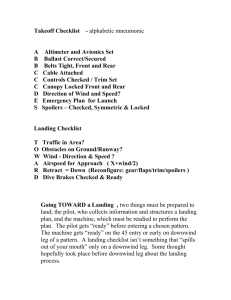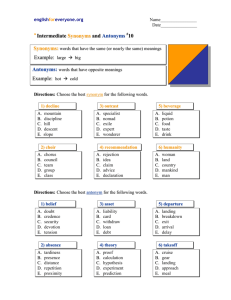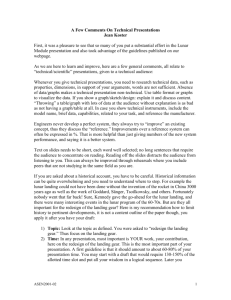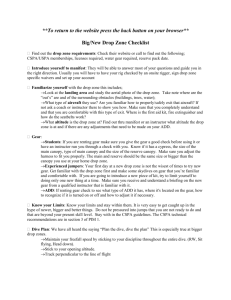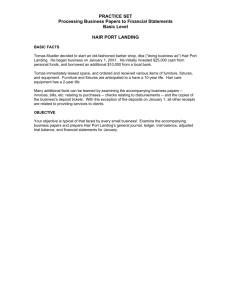XIII-A-Emergency
advertisement
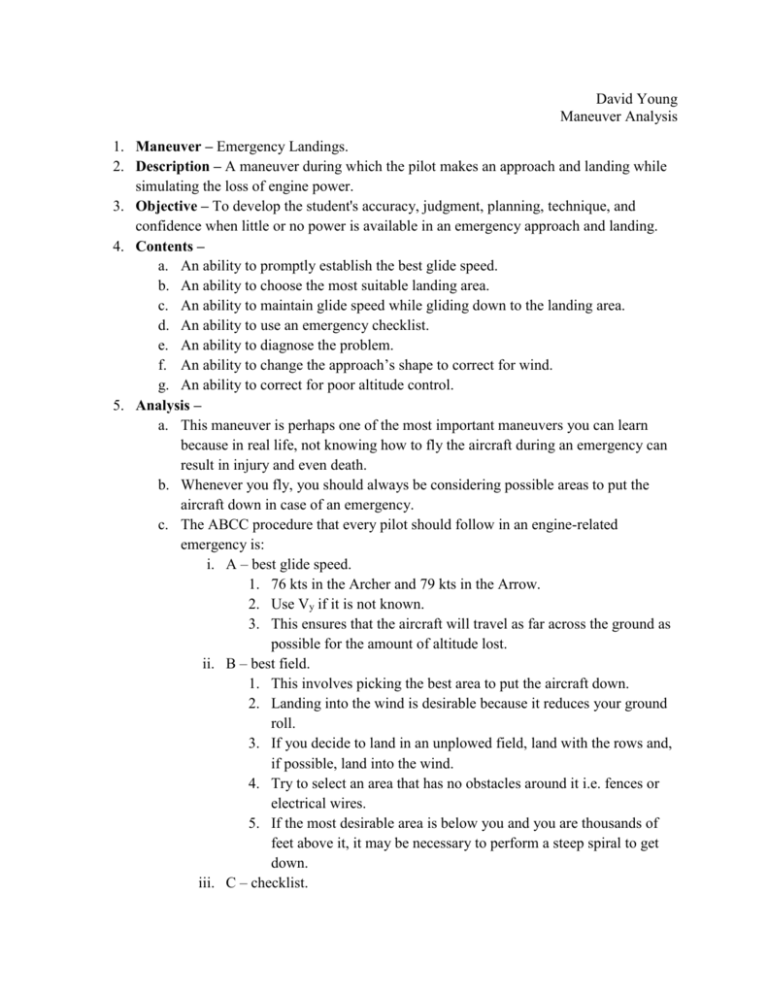
David Young Maneuver Analysis 1. Maneuver – Emergency Landings. 2. Description – A maneuver during which the pilot makes an approach and landing while simulating the loss of engine power. 3. Objective – To develop the student's accuracy, judgment, planning, technique, and confidence when little or no power is available in an emergency approach and landing. 4. Contents – a. An ability to promptly establish the best glide speed. b. An ability to choose the most suitable landing area. c. An ability to maintain glide speed while gliding down to the landing area. d. An ability to use an emergency checklist. e. An ability to diagnose the problem. f. An ability to change the approach’s shape to correct for wind. g. An ability to correct for poor altitude control. 5. Analysis – a. This maneuver is perhaps one of the most important maneuvers you can learn because in real life, not knowing how to fly the aircraft during an emergency can result in injury and even death. b. Whenever you fly, you should always be considering possible areas to put the aircraft down in case of an emergency. c. The ABCC procedure that every pilot should follow in an engine-related emergency is: i. A – best glide speed. 1. 76 kts in the Archer and 79 kts in the Arrow. 2. Use Vy if it is not known. 3. This ensures that the aircraft will travel as far across the ground as possible for the amount of altitude lost. ii. B – best field. 1. This involves picking the best area to put the aircraft down. 2. Landing into the wind is desirable because it reduces your ground roll. 3. If you decide to land in an unplowed field, land with the rows and, if possible, land into the wind. 4. Try to select an area that has no obstacles around it i.e. fences or electrical wires. 5. If the most desirable area is below you and you are thousands of feet above it, it may be necessary to perform a steep spiral to get down. iii. C – checklist. Young 2, XIII-A 1. Altitude-permitting (at least 1,000 ft AGL), perform a flow. a. This should involve switching the fuel tanks, turning on the fuel pump, using carburetor heat (if installed), using alternate air (if installed), moving the mixture to full rich, and increasing the throttle to max power. b. (If real-life) If you are unsuccessful in restarting the engine and you are committed to the landing, turn off the “fuel, flames and air” items as well as any electrical items. i. These include fuel selector, mixture, ignition, and throttle. ii. Turn the alternator and battery masters off only after you have extended the landing gear (if you decide to extend the gear). 2. If you are approximately 2,000 ft AGL, you should check the items in your checklist. iv. C – communicate. 1. Altitude-permitting, squawk 7700 and announce who you are, where you are, your situation, and what you are doing on 121.5. a. Do NOT perform this unless this is a real emergency. d. Selecting a suitable landing area is vital in the proper execution of this maneuver. i. During this maneuver, you must select the best landing area that is within gliding distance. 1. A rule of thumb to go by is that you will lose about 1,000 ft in a standard rate turn and about 500 ft in a 45º bank. ii. If there is any doubt as to whether or not you can make a landing area, do NOT try and stretch the glide to find out. iii. The hierarchy of landing areas you should pick are as follows (in order): 1. Airport. 2. Empty road. 3. Plowed field. 4. Unplowed field. 5. Trees. 6. Water. 7. Busy road. 8. Other. iv. Your main objective is to ensure the safety of those onboard and those on the ground. 1. Remember that saving the aircraft is secondary to saving lives. e. The following steps should be taken if the engine fails on or shortly after takeoff: Young 3, XIII-A i. If your engine fails/does not output full power while on the ground, reduce the power to idle and apply full brakes. 1. If you are quickly running out of runway space, lean the mixture to idle-cutoff. ii. If you have just lifted off, and you have runway left to land on, land on the available runway. iii. If you have just lifted off, you do not have runway available, but you have less than 2,000 ft AGL, pitch for best glide and land straight ahead. 1. Avoid obstacles. 2. Do NOT try and make the turn back to the airport because, in many cases, you will not be able to get back to the airport before completing your turn. iv. If you have just lifted off, and you have at least 2,000 ft AGL, you may consider coming back to the airport for a landing. 1. Remember to stay coordinated during your turn. f. If you must perform this maneuver in a real-life situation, attempt to land the aircraft with the least rate of descent possible, especially when landing on rough terrain. g. If you are PRACTICING an engine-out scenario in the air, begin the maneuver at no less than 500 ft over an uncongested area. i. At absolutely no point during this maneuver should you descend below 500 ft AGL (roughly 1,200 ft MSL near CMI) unless you will actually be landing out of this maneuver. h. You or your instructor will retard the throttle to idle and announce “simulated engine failure.” i. Execute the ABCC procedure. i. You must determine if you are going to extend your gear when you have the field made. i. If you are landing on a runway, plowed field, or trees, land with the gear down. 1. The gear can act as a barrier between you and any rough objects on your landing area. ii. If you are landing on an unplowed field or on water, land with the gear up. 1. The gear may cause the aircraft to inadvertently flip over upon touchdown, so keeping it up is probably the better option. j. If you are relatively low when you begin the maneuver (around 1,000 ft AGL): i. Head straight for your field. Young 4, XIII-A ii. If you are much too low, there is not much you can do other than slightly change your heading in an attempt to make a field that is a little closer to you. 1. Maintain best glide speed. iii. If you are too high, you may perform a forward slip or s-turns to help you lose altitude. iv. Try to land the aircraft as close to the beginning of the area as possible. k. If you are more than about 1,500 AGL when you begin the maneuver: i. Once you have your field selected, begin heading towards the high key point (refer to the cross on downwind on Figure A). 1. This is the point you should circle over if you must lose altitude. 2. Through varying your rate and radius of turn, try and time it so that you roll over your high key point on a downwind heading at approximately 1,000 ft AGL. ii. The rest of the maneuver is basically just a power-off 180. 1. Maintain your altitude in the same ways as you would on a power off 180. a. If you high, square off your turns, and perform s-turns if necessary. b. If you are low, head straight for your landing area. iii. Remember that the wind will strongly affect your groundspeed, so adjust your “traffic pattern” to compensate for the wind. iv. Begin deploying flaps once you definitely have the field made. v. If you decided to extend your landing gear (according to the suggestions in part (g)), extend the gear once you have definitely made the field. vi. Try to land the aircraft as close to the beginning of the area as possible. vii. Upon reaching 1,200 ft MSL, commence a go-around. 1. Retract one notch of flaps. 2. Once you have a positive rate on your VSI, retract your gear. 3. Pitch for Vx, and retract the second notch of flaps at Vx. 4. Pitch for Vy, and retract last notch of flaps at Vy. 5. Climb to a safe altitude or as specified by your instructor/examiner. 6. Visual Cues – a. Use the horizon and the engine cowling to help maintain the best glide pitch. b. Use the field to help you determine if you are too high. c. Hold your sight picture constant during a balloon or an inadvertent liftoff. 7. Instrument Cues – a. Use the altimeter to determine altitude. b. Use the airspeed indicator to monitor airspeed. Young 5, XIII-A c. Use the inclinometer to stay coordinated. 8. PTS Standards – a. Private Pilot – i. Exhibits knowledge of the elements related to emergency approach and landing procedures. ii. Analyzes the situation and selects an appropriate course of action. iii. Establishes and maintains the recommended best-glide airspeed, ±10 knots. iv. Selects a suitable landing area. v. Plans and follows a flight pattern to the selected landing area considering altitude, wind, terrain, and obstructions. vi. Prepares for landing, or go-around, as specified by the examiner. vii. Follows the appropriate checklist. b. Commercial Pilot – i. Exhibits knowledge of the elements related to emergency approach and landing procedures. ii. Analyzes the situation and selects an appropriate course of action. iii. Establishes and maintains the recommended best glide airspeed, ±10 knots. iv. Selects a suitable landing area. v. Plans and follows a flight pattern to the selected landing area considering altitude, wind, terrain, and obstructions. vi. Prepares for landing, or go-around, as specified by the examiner. vii. Follows the appropriate checklist. 9. Common Errors – a. Improper airspeed control. b. Poor field selection. c. Failure to correct for wind. d. Failure to fly a suitable pattern down to the field. e. Failure to use a checklist. f. Undershooting/overshooting the field. 10. References – a. AFH, Ch. 16 b. Gleim’s Flight Instructor Flight Maneuvers, Part II, Unit XIII c. FAA-S-8081-12B d. FAA-S-8081-14A Young 6, XIII-A Figure A

